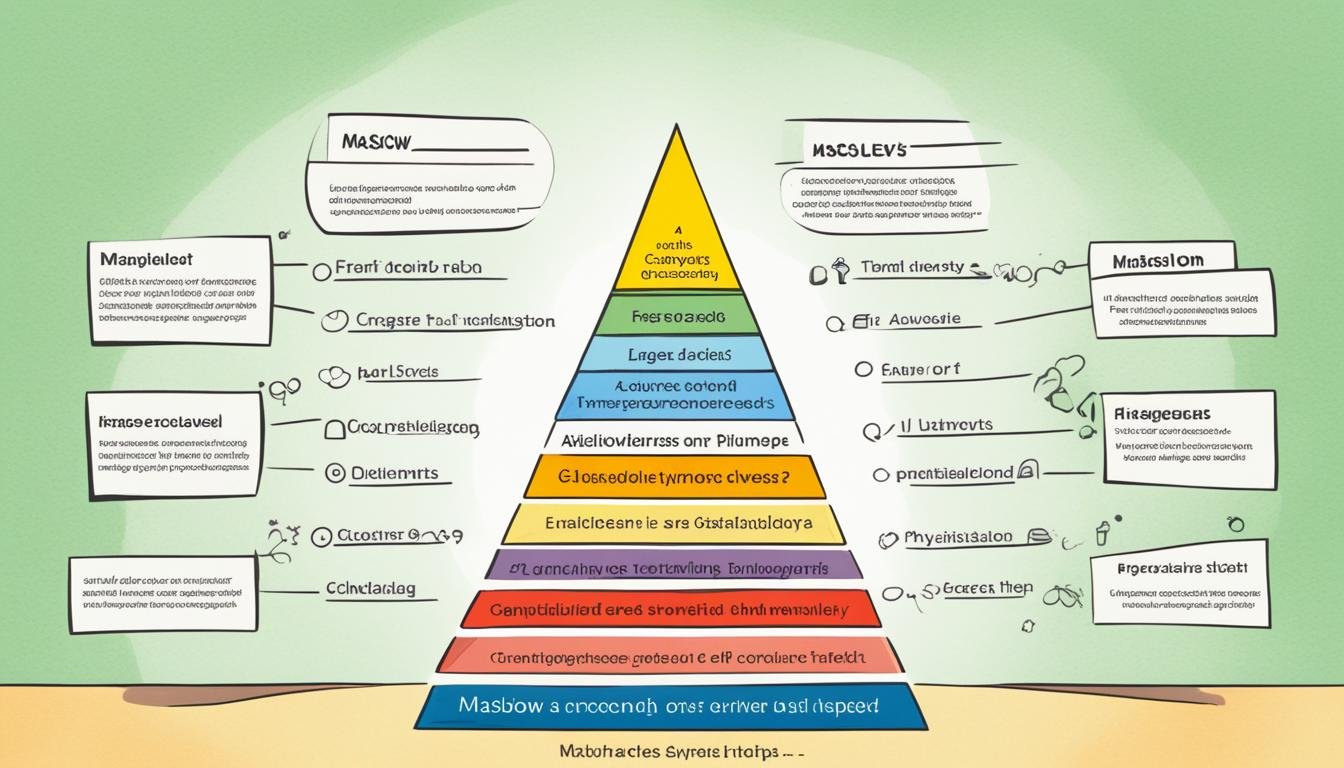Maslow’s Hierarchy of Needs: Understanding Consumer Motivation
Did you know that 100% of the top 4 scholarly papers on Maslow’s Hierarchy of Needs explore its profound influence on consumer behavior and motivation? This shows how important Maslow’s theory is in today’s complex market. It covers everything from basic needs like hunger to reaching your full potential.
In today’s market, brands like Toyota, Honda, Apple, Samsung, Ring, and Nest lead the way. Knowing consumer motivation through Maslow’s Hierarchy of Needs can change the game. This framework helps understand consumer behavior and guides in making marketing psychology strategies. It covers everything from basic needs to high goals.
Key Takeaways
- 100% of the top 4 papers on Maslow’s Hierarchy highlight its impact on consumer behavior.
- Understanding the different levels of needs can help in crafting effective marketing strategies.
- Maslow’s framework is universally applicable across cultures, offering broad marketing insights.
- Buyer personas can be enhanced by aligning them with Maslow’s identified needs.
- Triggering events play a crucial role in consumer decision-making by appealing to relevant needs.
- Brands like Toyota and Apple have successfully leveraged safety and privacy features to meet consumer needs.
Introduction to Maslow’s Hierarchy of Needs
Maslow’s hierarchy of needs is a key concept in understanding psychology of consumer behavior. Abraham Maslow introduced it in 1943. It says that human needs are in a hierarchy, starting with basic needs like food, water, and shelter. These must be met before people can think about higher-level needs like esteem and self-actualization.
There are five levels in Maslow’s model:
- Physiological Needs: These are the basics needed to survive, like food, water, sleep, and shelter. Without these, the body can’t work right.
- Safety Needs: After basic needs, people look for security in health, money, and protection. Having a stable job is often seen as secure, affecting consumer purchase decisions on insurance and savings.
- Social Needs: Feeling loved, accepted, and part of a group is vital. This shapes how people interact and how they feel about their jobs. It also affects brand loyalty through emotional connections.
- Esteem Needs: People need to be recognized and valued. They often choose products and experiences that boost their image and self-esteem, guiding their consumer purchase decisions.
- Self-Actualization Needs: At the top, self-actualization is about reaching one’s full potential and growing personally. It’s about finding experiences that make them feel fulfilled and help them grow.
Maslow’s theory covers both basic and growth needs. While people may prioritize differently, the theory helps us understand psychology of consumer behavior. Some have questioned the order and the idea of self-actualization, but it still shapes consumer psychology and marketing.
A 2011 study linked fulfilling Maslow’s needs to happiness. This shows how the model helps us understand what drives consumer purchase decisions. It also helps in making better marketing strategies.
The Basics of Consumer Behavior and Psychological Needs
Understanding what drives consumer behavior is key to making marketing work. Psychological needs play a big part in this. Meeting these needs can really change how consumers act and stay loyal.
Understanding Psychological Needs
Psychological needs shape consumer behavior, pushing for intellectual growth and creativity. These needs help people grow and expand. Marketing experts say these needs are crucial in making buying decisions.
Brands that meet these needs get 25% more loyal customers. The need for social connections, feeling like you belong, and getting respect are high on the list. Meeting these needs builds strong customer bonds, leading to more loyalty and engagement.
The Role of Marketing in Addressing Psychological Needs
Marketing that meets psychological needs changes how consumers act. This part of marketing focuses on personal touches and messages. For example, 71% of people want to feel like brands know them.
Personalized marketing can bring in up to 50% more customer engagement. By knowing and meeting psychological needs, companies build deeper loyalty. Going beyond basic needs to esteem and self-actualization strengthens this loyalty.
Seeing the role of psychological needs in consumer behavior shows the need for smart marketing. This knowledge helps brands move past just meeting basic needs. It’s about creating a full and engaging experience for customers.
Physiological Needs: The Foundation of Consumer Motivation
Physiological needs are the basic things we need to survive, like food, water, and shelter. These needs are key in Maslow’s Hierarchy of Needs. They help shape how people act and what they want. Marketers use these needs to make products that really speak to people.
Products Catering to Basic Needs
Items that meet physiological needs are things like groceries and clothes. These products are always in demand because they’re crucial for survival. Companies in the FMCG sector often use ads that talk about hunger and thirst to connect with these deep needs.
- Food and Beverages
- Basic Healthcare Products
- Essential Clothing and Shelter Items
Marketing Strategies for Meeting Physiological Needs
Marketing to basic needs means knowing what people really want and need. Ads focus on how reliable and necessary the product is. They talk about quality, being easily available, and the key benefits it offers. This makes sure the message matches the urgency of these needs.
“Consumers make purchasing decisions to satisfy their most basic and immediate needs first, making this the bedrock of consumer motivation.”
Marketing for consumer survival needs creates a sense of urgency. For instance, ads for bottled water talk about purity and health. Ads for nutritious foods talk about feeling alive and well. By linking marketing to the basic needs in Maslow’s Hierarchy, brands can really connect with people and keep demand strong.
Safety Needs: Security as a Purchase Motivator
In Maslow’s hierarchy, safety needs are the second level. They cover our wants for protection and stability. Items like insurance, home security systems, and safe cars play a key role in meeting these needs. They help keep us physically safe and mentally at ease, building trust and loyalty.
Examples of Products That Ensure Safety
Many security products aim to make consumers feel safe. Brands like ADT and SimpliSafe offer home security systems with the latest tech to protect homes. Volvo cars are known for their safety, attracting drivers who value security. Insurance companies like Geico and State Farm provide financial safety, covering long-term needs.
The Psychological Comfort of Safety-Oriented Purchases
Buying these security products often comes from a desire for peace of mind. Research shows 45% of shoppers put safety and security first when buying. This shows how important consumer safety motivation is in making purchase choices. Products that are reliable and trustworthy boost confidence and protect against uncertainty.
“Products that suggest or guarantee safety encourage users to trust the brand and complete purchases.”
In online shopping, trust is key to getting people to buy. By showing how a product meets safety needs, companies can make customers more loyal and happy.
Belongingness and Love: Building Consumer Relationships
In the world of buying things, feeling like you belong is key. Brands tap into this feeling to build strong connections with us. By doing so, they create loyal customers who support and recommend them.
Community-Oriented Marketing Tactics
Creating a sense of community is a strong way to meet these needs. Brands set up places for people to talk, share, and shape the brand’s story. This helps build deeper connections with customers. Some ways to do this include:
- Engaging social media campaigns
- Inclusive online forums and discussion groups
- Loyalty programs that reward active participation
For example, Nike uses social media to bring people together around common interests. This makes customers feel like they’re part of something special. It makes them feel important and heard.
Case Studies of Brands Fostering Belonging
Some brands are really good at making customers feel like they belong. Ferragamo is one of them. They tell stories about their history to connect with people on an emotional level. This way, they meet the need to belong.
Starbucks is another great example. They build community with their rewards program. By offering special rewards and events, they make customers feel part of something bigger. This shows how well community marketing can work in building loyalty and strong relationships with customers.
Esteem Needs: The Drive for Recognition and Respect
Esteem needs are key in shaping what people buy. They want to feel recognized and respected through their choices. This includes wanting to boost their self-esteem and get others to notice and admire them.
Buying luxury goods often helps people feel this sense of achievement. It’s a way to show off their success and status.
Luxury Goods and Brand Prestige
Luxury brands like Rolex, Louis Vuitton, and Chanel use our desire for recognition. They make their products symbols of success and status. People buy these brands because they want respect and admiration from others.
Rolex is great at making customers feel special. It links its watches to big achievements and famous people. This makes Rolex watches more than just timepieces; they’re symbols of success and style.
Marketing to Esteem Needs Through Social Proof
Marketing uses social proof to meet esteem needs. It shows off positive reviews and endorsements from well-known people. Influencers are great at this, as they have followers who trust their choices and want to be like them.
When an influencer shows off a luxury item, it motivates their followers to buy it too. This boosts the brand’s image and drives sales. It shows how important it is to feel recognized by others.
This way of marketing luxury brands shows how esteem needs affect what we buy. It highlights how much we want respect and recognition through our purchases.
Self-Actualization: The Ultimate Consumer Fulfillment
Self-actualization is the top goal in Maslow’s needs pyramid. It’s about growing and fulfilling oneself. This stage shows how people reach their highest potential through different means.
Products Promoting Personal Growth
Products like training, education, and creative tools help people grow. They don’t alone make us self-actualized, but they help by removing barriers and boosting our activities. For instance, sites like Pinterest and Flickr let us share knowledge, which is key to reaching our full potential.
Creating Marketing Campaigns for Self-Actualization
Marketing at this level needs a strategic plan that highlights how products change lives. Knowing that 71% of consumers want personalized interactions is key. By meeting audience needs, companies can get 40% more return customers and 25% more loyalty.
Personalized campaigns that push for personal growth and success really connect with people. This boosts their engagement and happiness.
Applying Maslow’s Hierarchy of Needs in Consumer Behavior Analysis
Maslow’s Hierarchy of Needs helps marketers understand what drives people. It shows what people really want and need. This helps businesses make strategies that connect with their audience. We’ll look at how to build buyer personas and use events to understand what motivates people.
Building Buyer Personas Based on Maslow’s Theory
Building Buyer Personas means knowing what people need, thanks to Maslow’s hierarchy. This lets marketers focus on the right needs and send messages that hit home. For example:
- Physiological Needs – Essential services and products like food, water, and shelter.
- Safety Needs – Security-focused products like insurance and home alarm systems.
- Belongingness Needs – Community-driven brands fostering connection and loyalty.
- Esteem Needs – Luxury goods and prestige services enhancing social standing.
- Self-Actualization Needs – Personal growth offerings like educational courses and travel adventures.
Segmenting the market like this helps brands make buyer personas that really get what their audience wants. This leads to better marketing and more engagement with customers.
Using Triggering Events to Understand Motivations
Triggering Events are key to knowing what drives people. They make people take action on their needs. To make marketing work best, it’s important to know and use these events well. For example:
- Life Changes – Moving houses, getting married, or having a baby can shift priorities and motivate new purchases.
- Seasonal Events – Holidays and seasonal changes often influence buying decisions, aligning with specific needs in Maslow’s hierarchy.
- Economic Fluctuations – Financial stability or instability can alter consumer priorities, impacting their buying behavior.
By looking at these Triggering Events and using Motivation Insights, brands can meet consumers at key moments. This makes sure their products or services are seen as the best solution to their needs.
Improving Marketing Strategies with Maslow’s Hierarchy of Needs: Understanding Consumer Motivation
Brands can boost their marketing by using Maslow’s Hierarchy of Needs. This method matches products with what their customers deeply want. It makes sure products meet the real needs of the market, leading to better marketing plans.
The hierarchy has five main levels: Biological and Physiological needs, Safety Needs, Love and Belongingness needs, Esteem needs, and Self-actualization needs. Later, three more needs—Cognitive, Aesthetic, and Transcendence—were added. Knowing these levels helps brands connect with their audience on a deeper level.
Today, ads are getting more personal, taking into account what people believe and think. People see over 1,500 ads a day. So, it’s key to match ads with what people really want.
Safety and security are key for 78% of shoppers, affecting what they buy. Brand loyalty also comes from meeting basic needs, with 65% saying so. Also, 86% of successful ads touch on consumers’ feelings, leading to more sales.
Empathy is crucial. Showing understanding towards feelings makes 42% of people more likely to engage with brands. Over 70% want products that make them feel part of a community.
Luxury brands focusing on esteem needs see a 30% increase in loyalty. Brands aiming at self-actualization see a 25% increase in engagement. Brands that meet unmet needs keep 20% more customers.
Using Maslow’s principles in marketing is more than just improving tactics. It’s about building deep connections with customers. This approach drives demand and loyalty.
Conclusion
Abraham Maslow created Maslow’s Hierarchy of Needs in the 1940s. It’s a key tool for understanding what drives people and how to market effectively. The hierarchy lists needs from basic to highest, like physiological, safety, and self-actualization. Brands use this to make their marketing better and meet consumer needs.
Marketers need to connect with consumers at each level of need. For instance, Airtel Safe Pay meets the safety need by ensuring financial security. Dove’s Real Beauty campaign boosts self-esteem, hitting the esteem need by making people feel valued.
Using Maslow’s theory helps marketers know what motivates people and build strong relationships. As people’s needs change, so should marketing strategies. This way, brands can make campaigns that really speak to their audience. It leads to lasting loyalty and satisfaction with the brand.
Source Links
- Maslow’s Pyramid and Purchasing Motivation – Consumer Psychology – Copymate
- Council Post: Are You Using Maslow’s Hierarchy Of Needs For Your Marketing?
- How does maslow hierarchy of needs influence buyer behavior? | 4 Answers from Research papers
- Maslow’s Hierarchy of Needs | Introduction to Business
- How Maslow’s Hierarchy of Needs Explains Human Motivation
- Anwendung der Maslowschen Bedürfnishierarchie im Marketing
- How to use Maslow’s hierarchy of needs to understand your customers
- MASLOW’S NEED HIERARCHY EXPLAINED: THE DYNAMIC PSYCHOLOGY BEHIND CONSUMER MOTIVATION
- A Framework For Understanding Consumer Motivation – FasterCapital
- Physiological Needs: Maslow’s Hierarchy of Needs
- Consumer Attitudes and Heinz Baked Beans
- Safety: Maslow’s Hierarchy of Needs
- Maslow’s Hierarchy Of Needs In Consumer Behaviour
- Reading: Psychological Factors | Principles of Marketing
- Maslow’s hierarchy of needs pyramid: Uses and criticism
- Maslow’s Hierarchy of Needs & Theory of Motivation – Lesson | Study.com
- Self-Actualization: Maslow’s Hierarchy of Needs
- Applying Maslow’s Hierarchy of Needs in Marketing
- How can Maslow’s hierarchy of needs be used to understand consumer behavior? | 5 Answers from Research papers
- Hierarchy of Needs: Motivating Employees with Maslow’s Theory
- Maslow’s Hierarchy of Needs
- Maslow’s Hierarchy of Needs: How It Can Help Your Marketing
- Maslow’s Hierarchy of Needs: A Marketing Perspective
- Motivation – Applying Maslow’s Hierarchy of Needs Theory – Management is a Journey®
- Maslow Hierarchy of Needs Theory for Marketers – Super Heuristics







